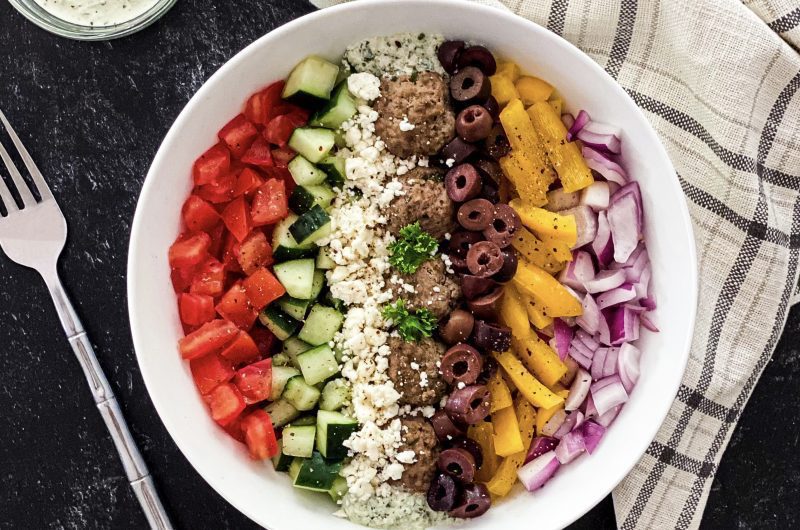When you think of “Mediterranean cuisine,” what’s the first thing that comes to mind? Perhaps Greek food? Indeed, traditional Greek cuisine is a quintessential part of the Mediterranean Diet. Of all Greek dishes, the Greek salad is one of the most popular and well-known around the globe. Here at That Salad Lady, we love a good Greek salad. But we’ve kicked this classic staple up a notch by adding lamb to create a hearty and wholesome “Lamb Meatball Greek Salad.”

You’re probably thinking, “Meatballs in a Greek salad?” After all, a Greek salad is typically meatless and loaded with lots of fresh veggies.
While the traditional Greek salad can surely stand on its on as a vegan-friendly blend, the addition of lamb meatballs brings layers of savory flavor, quality protein and other essential nutrients to the bowl. Whether you’re a fan of Mediterranean food or just looking to try something new, this one’s for you. Keto- and paleo-friendly, gluten-free and incredibly filling, our Lamb Meatball Greek Salad will leave you feeling well-nourished and completely satisfied.
THE BALANCING ACT
As lamb is one of the main animal proteins in the Greek diet, our recipe stays true to this Mediterranean eating style. Still, many wouldn’t put it at the top of their healthy foods list. Lamb is a red meat. Red meat itself has long been viewed as a dietary devil, shunned for its high saturated fat content. Here at That Salad Lady, we’re all in for inclusivity when it comes to healthy eating. Rather than shunning foods, we focus on maximizing their nutritional value.
Despite widespread belief, saturated fat alone poses no health risks, so there’s no need to abstain from eating lamb or other high-quality red meats for health reasons (learn more about saturated fat and other dietary fats). As a major source of protein, B vitamins and powerful antioxidants, lamb is among the most nutritious of red meats. The key to eating it (and any other whole foods) lies in portion control.

Below we suggest sensible portions of our lamb meatballs – just enough to complement all the fresh flavors of the salad ingredients. Our recipe also calls for arugula, which complements the bold flavors of the lamb. It makes lamb easier to digest too. If you’re following a particular diet and choose to leave the lamb meatballs out, we promise you’ll still have an enjoyable eating experience. However, if your diet is more all-inclusive, by all means, leave them in.
So, what’s in the Lamb Meatball Greek Salad recipe and why?
Lamb and Other Traditional Greek Foods
You’ve probably already guessed that lamb is the first ingredient in this salad bowl. Our recipe calls for ground lamb to be seasoned and then shaped into meatballs. You’ll find a simple yet flavorful blend of dried herbs and freshly minced onion, garlic and parsley for seasoning. We suggest using grass-fed ground lamb, as it’s naturally higher in antioxidants and has a superior ratio of polyunsaturated fats (learn more about polyunsaturated fat and other dietary fats).

Our recipe also includes feta cheese and kalamata olives, both of which are classic Greek foods and staple ingredients in a traditional Greek Salad. In addition to the protein feta brings to the bowl, it offers a nice tangy balance that brings out the fresh, earthy flavors of the salad layers. The flavor of feta is complemented by the distinctly fruity, almost smoky flavor of the olives, which also happen to be chock-full of antioxidants and monounsaturated fat.
A Fresh and Colorful Blend of Salad Layers
As you’ve probably already guessed, the “Greek Salad” itself isn’t one of That Salad Lady’s original conceptions. In addition to feta cheese and olives, the traditional salad is made with tomato, cucumber, bell pepper and red onion. Besides being high in fiber, this colorful collection of fruit and veggies contains a cocktail of antioxidants and phytonutrients known to protect against heart disease, high blood pressure, diabetes, inflammation and various cancers.

While a traditional Greek salad doesn’t contain any leafy green veggies, we include arugula in our recipe as well. As with other leafy greens, it’s rich in vitamin K and chlorophyll, a natural green pigment known to boost energy and fight disease. With its rich, peppery flavor, arugula not only complements the bold, savory flavors of the lamb, but the chlorophyll it contains promotes healthy digestion of the lamb and other proteins.
Tzatziki Dressing for a Tangy Finish
While you can easily dress our Lamb Meatball Greek Salad with your favorite vinaigrette or even a simple blend of extra-virgin olive oil (EVOO), lemon juice and dried herbs, it’s made even more authentically delicious with That Salad Lady’s homemade tzatziki blend. Tzatziki is a classic Greek pairing for lamb. Ours is a blend of Greek yogurt, packed with health-promoting probiotics and protein, EVOO, red wine vinegar, lemon juice and fresh parsley.

We can promise that our tzatziki dressing won’t disappoint. It’s refreshingly light and mildly tangy taste enhances all the rich flavors of our ingredient combo. Even better, the dressing comes together in less than 10 minutes!
GET COOKING
Of all ingredients in our Lamb Meatball Greek Salad bowl recipe, cooking is only required for the meatballs. That’s it! Once you’ve seasoned the ground lamb with our seasoned blend, you’ll simply shape it into meatballs and pop them in the oven for 20 minutes. You can use the cooking time to prepare the rest of your ingredients.

GET YOUR CHOP ON
Our recipe calls for chopping most of the salad ingredients including the tomato, cucumber, bell pepper and red onion. No chopping is needed for the arugula, as you can buy it either by the bunch or as loose leaves.
Feel free to use whichever tomatoes you have on hand (we use Roma) and simply dice them into small chunks. If using smaller tomatoes, like cherry or grape varieties, just slice those in half. Slicing (regular) and English (seedless) cucumbers both work for the recipe. If you go with a slicing cucumber, we suggest seeding it to reduce the water content. Whether a slicing or an English cucumber, you can either dice it into chunks or slice it into half-moons.
As you’ve probably noticed, we use yellow peppers for the salad bowl. We chose yellow to add more color to the blend – any color bell pepper will do the trick. As green peppers are generally the least sweet and the lowest in nutrients, we suggest choosing from the brighter colored varieties. Simply slice the bell pepper into thin strips or dice it into small chunks. You can also dice the red onion into small chunks or julienne it.
Once you’ve chopped up your ingredients, set them aside until you’re ready to build your bowl.
START MINCING AND MIXING
Our tzatziki dressing blend calls for freshly minced garlic and cucumber. Garlic is most effective when it’s freshly crushed or cut. You can mince garlic with a garlic press or a high-quality chef’s knife. While you can use jarred minced garlic as a “shortcut,” we don’t recommend doing this. Jarred versions tend to have “off” flavors, which’ll be detectable in your finished dressing.
We also suggest mincing or finely chopping the cucumber in advance of making the dressing. You can mince cucumber with either a flat or box grater, or a food processor. Again, slicing and English cucumbers both work. However, you don’t have to seed the cucumber in this case (see recipe card).
Once you’ve minced your garlic and cucumber, you’ll just blend or mix all the dressing ingredients to your desired consistency. Start by simply adding everything to your blender or food processor. With variable speed units, start with a low speed and then gradually increase it to a higher speed until the mixture is perfectly smooth. That’s it!

BUILD YOUR SALAD BOWL
The final step is to build your bowl – or plate. Depending on how much you choose to eat or serve (your portion sizes), simply divide the arugula evenly and then arrange the fresh salad ingredients, olives and feta cheese in their own sections. From there, just place the meatballs on top. If presentation isn’t an issue, combine all the ingredients and gently stir them up for a nice, even color distribution.

Whether you use our tzatziki dressing or another type, we recommend adding it by the portion to avoid soggy ingredients, especially if you’re planning for leftovers. Add 1-2 tablespoons of dressing for each portion.
All put together, our Lamb Meatball Greek Salad is large enough for 4-6 generous servings. This doesn’t include the tzatziki dressing. Since it’s packed full of quality protein, good fats and fiber, you’ll get plenty of nutrition bang for your buck.
As we mentioned earlier, a traditional Greek salad is meatless so feel free to build your bowl without the meatballs. If you choose to go the meatless route, we recommend dressing your salad with either a vinaigrette or a homemade blend of EVOO, lemon juice and dried herbs. Tzatziki dressing pairs better with lamb.
SHOW US YOUR BOWL
That Salad Lady wants to see your bowl! If you like it, which we are sure you will, drop a comment below and tag pics on Instagram with @thatsaladlady, #thatsaladlady and #buildyourbowl. If you love it, pin it on Pinterest and share it on Facebook and Twitter using #thatsaladlady.
This information is provided as a courtesy and is only an estimate. Please review our full disclaimer to get a clear understanding of the nutrition and health information and resources presented and written on our website.








Pingback: 5 Salad Recipes for Spring Cleaning Your Diet - That Salad Lady